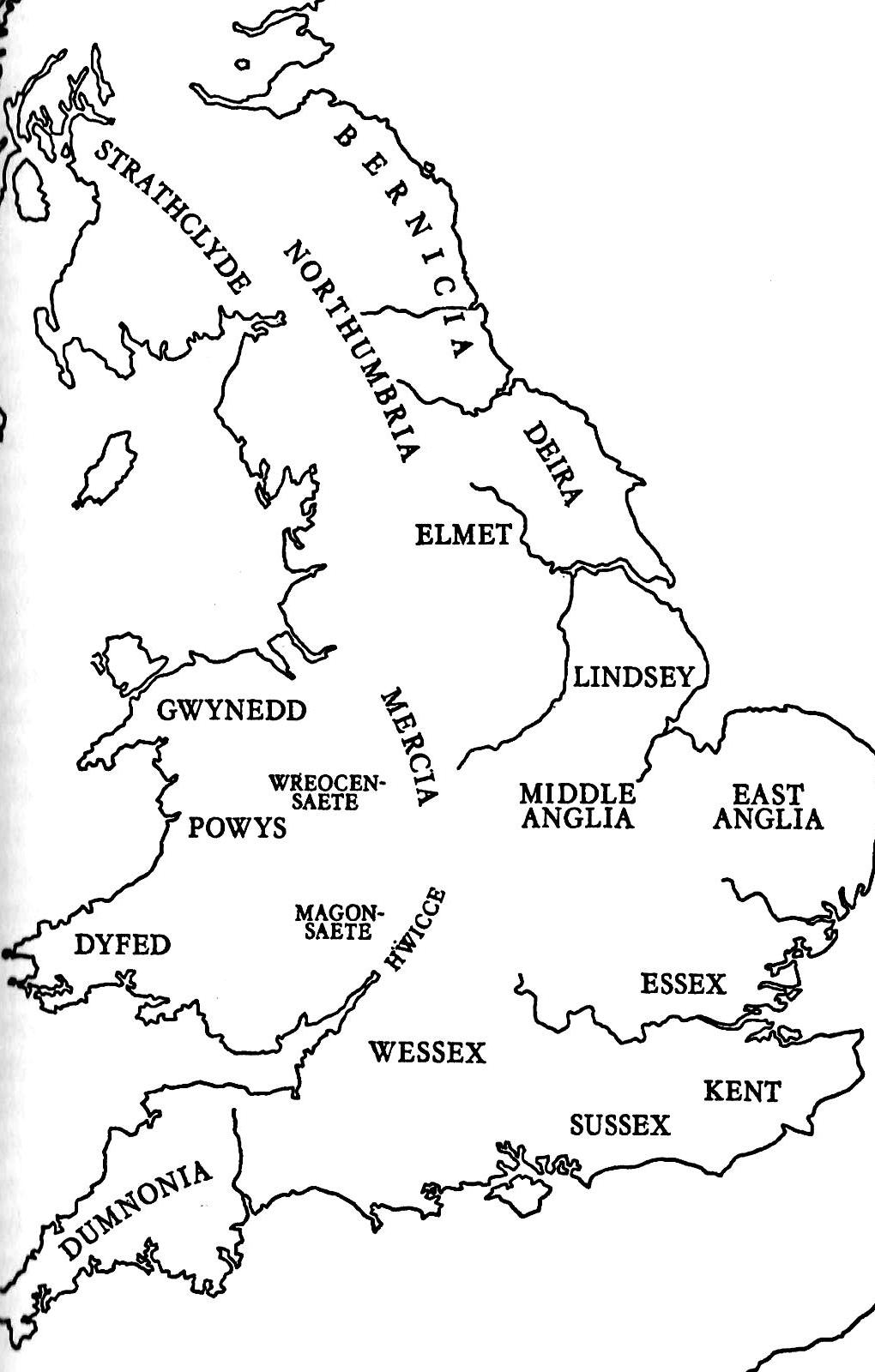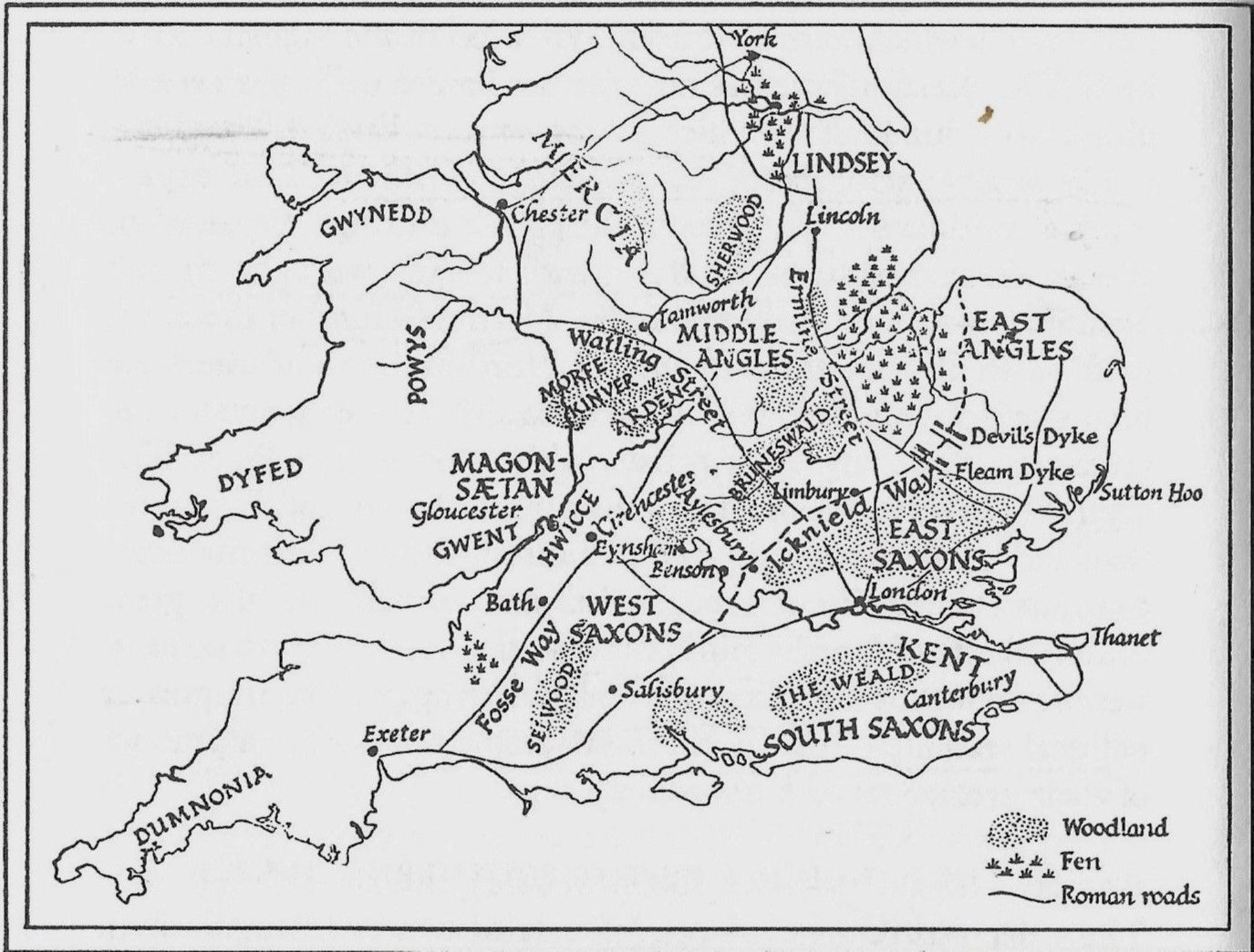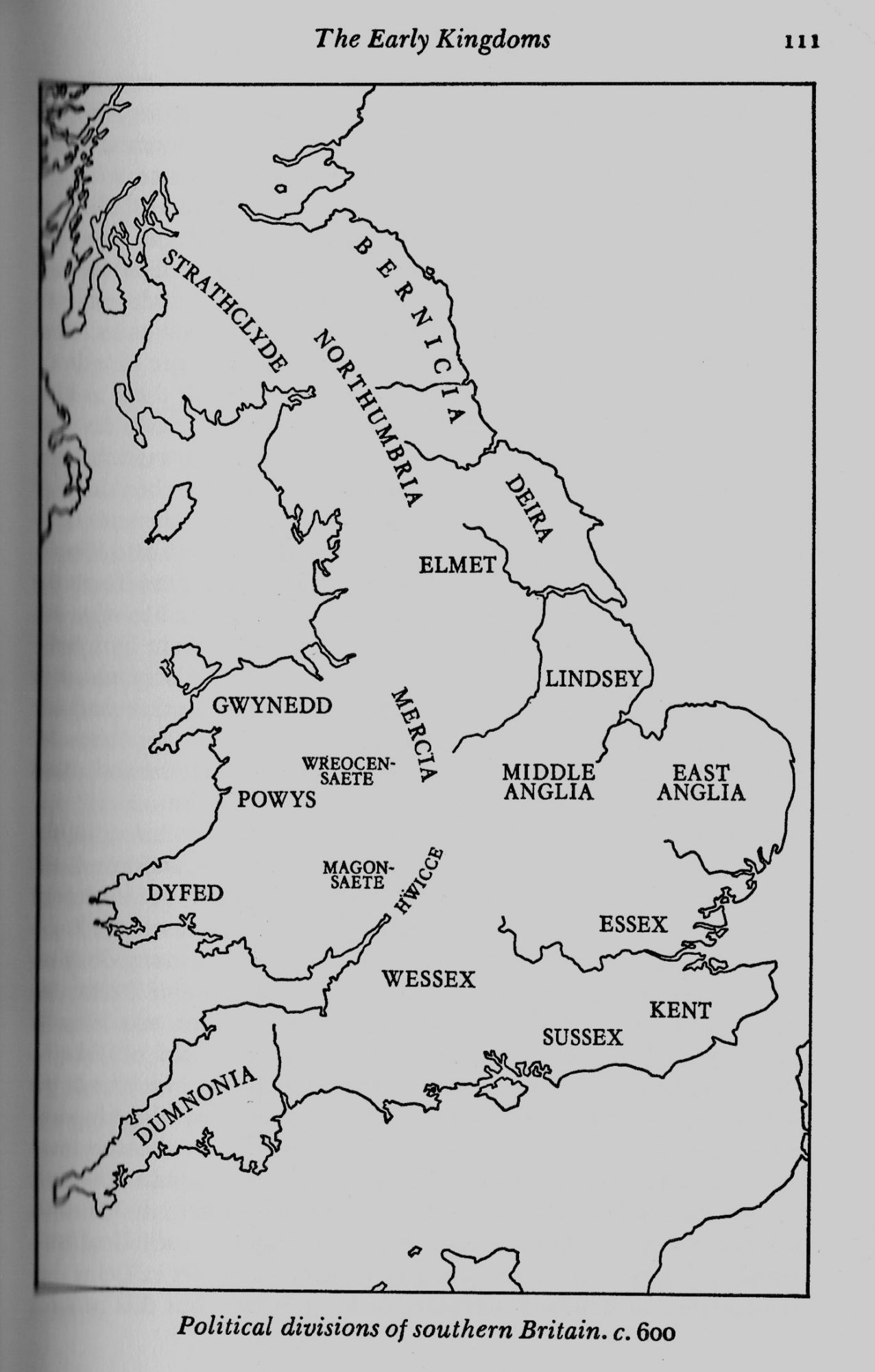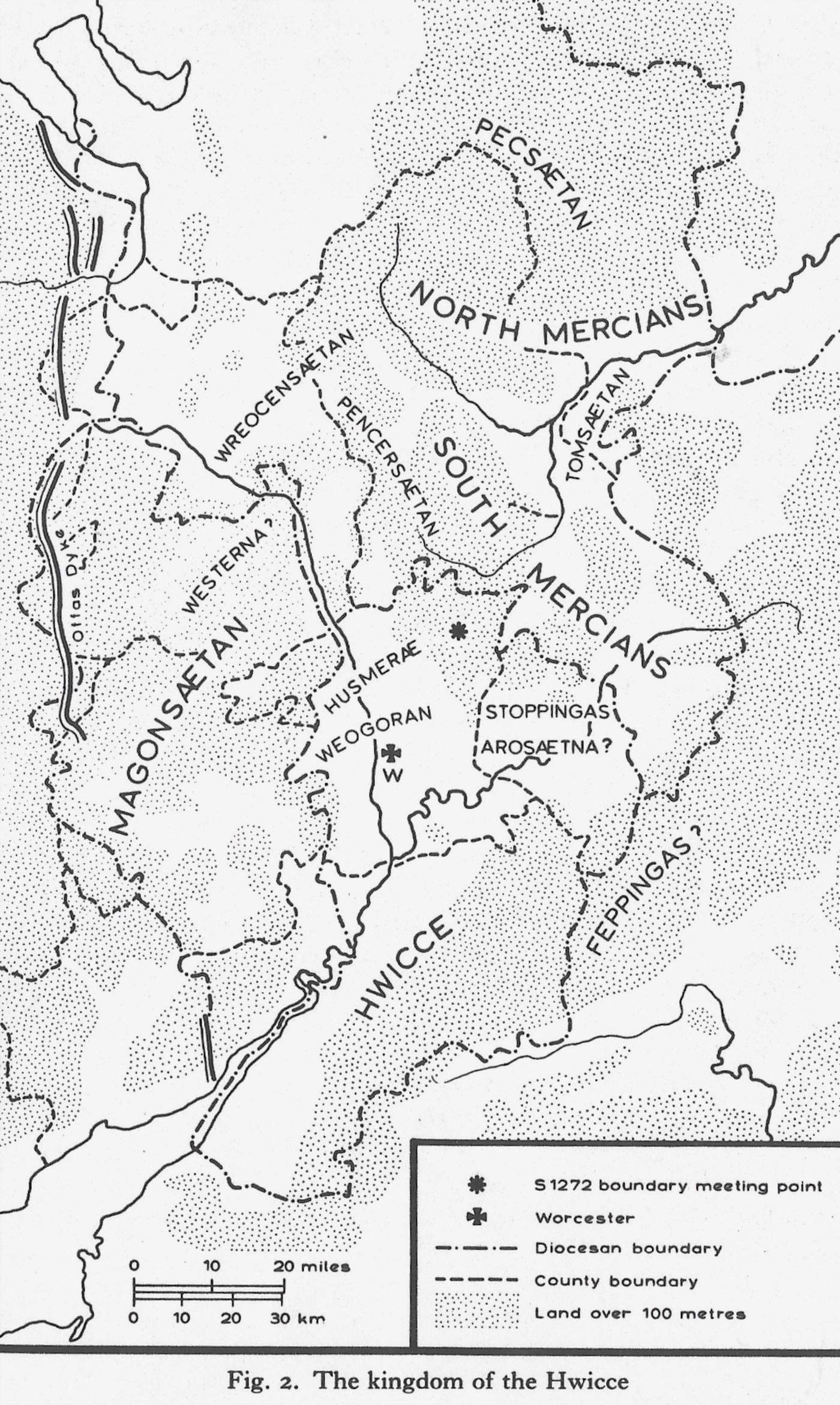A SIDE TRIP TO THE KINGDOM OF HWICCE

As some of the Wicken were making their way down into the Weald of Kent, eventually to establish a Wicken den in the manor, parish and finally the village of Cowden, other Wicken were taking a side trip - moving north to East Anglia and then across the midlands to the West. Originally, they were assigned by Vortigern to defend London against possible attack by the Picts from the north. These Wicken settled communities along a line of defense running from Canterbury to London and up past Cambridge to the Wash. A century later they made a precisely coordinated march to the west and settled continuous settlements among the Middle Angles. Finally, they arrived at the Western Midlands, where they changed their name from Wic-ing or the plural Wic-ingas (pronounced Huweek-) to Hwicc-e (pronounced Wick-) in order to clear up confusion between themselves and other tribes settled in multiple wics and wiches, and they established the Kingdom of Hwicce. Centered around Worchester and Gloucester and reaching south toward Bath, this kingdom includes a half-dozen places with names derived from the Wicken. The history reads as follows:
"In the fifth century CE, the former province of Britain was invaded by Germanic tribes from the continent - Angles, Saxons, Jutes and other lesser tribes. These peoples settled the lowlands, gradually pushing westwards into what are now the foothills of Wales and the moors of Devon. Eventually these Germanic-speaking settlers formed a culture which they called English, and a geographical entity which they called England (Michael Wood in Domesday: A Search for the Roots of England).
"The end of Roman rule in Britain is usually taken as AD 410, which is what the English historian Bede through , writing in 731. It fits with the fifth-century Byzantine historian Zosimus who describes the Emperor Honorium in AD 410 refusing a formal request for military aid from the local city authorities in Britain. ... Archaeological evidence suggests that life carried on with some degree of prosperity until around 450. ... According to later traditions preserved in the Anglo-Saxon Chronicle - of which the earliest surviving manuscript dates to c.890 - and Nennius' History of the Britons, c. 830, it was internecine warfare which led to the hiring of Germanic mercenaries to fight for both sides. ... Bede dated the "Coming of the English" to 447-9, about the time that two South Gaulish chronicles say that "Britain fell under the control of the Saxons."
The Anglo-Saxon Conquest - Blair writes that the traditions about the invasions, and particularly the narrative of Gildas, seem to suggest that there were three distinct phases leading to the Anglo-Saxon conquest of Britain.
Phase I. The first of these included a period of largely successful adaptation to the conditions resulting from the reduction of the armed forces in Britain by transfer of many [Roman] units to Gaul. Later it became necessary to increase the armed strength of the country and this was done by the employment of Germanic mercenaries, a step which was at first successful, but in the end fatal. The hirelings rebelled and with the support of reinforcements from home overran much of the country. They were met with organized resistance from the British who eventually won a great victory over them and with this victory which we may place c. 500, admitting a possible error of a decade on either side, the first phase comes to an end.
Phase II. The second phase, introduced by the British victory at Mons Badonicus, was one of equilibrium, if not of British supremacy over the attackers. It endured during the lifetime of Gildas, that is at least till 548, and perhaps it endured over much of midland and southern England until c. 571..
Phase III. The third phase begins with what has the appearance of a major English victory in that year 571 and the renewal of the advance which marked the final defeat of the British.
[References to Hwicce in the following have been underscored for ease of viewing.]
The author notes that "the invaders had already begun to make further progress in the south before the victory of 571," and after citing several battles writes that the victory in 577 of the Wessex at Dyrham resulted in the conquest by the English of Glouster and Cirencester, as well as Bath itself," towns which mark the eventual Kingdom of Hwicce. It is possible, then, that the Hwicce were actively involved in this conquest and that the foundations for the Kingdom of Hwicce were laid at that time. The history of Mercia first emerges from obscurity during the reign of Penda (c. 632-550, who may have promoted the area settled by the Hwicce as a kingdom in order to provide a buffer between Mercia and the West Saxons. An excellent description of the history of the Hwicce may be found at KINGDOM OF HWICCE.
History of the Kings and Kingdom of Hwicce - In Green's Making of England, the author notes that Theodore set the "bishop of the Hwiccas" at Worcester; and his diocese included both the counties of Worcester and Gloucester, as well as the adjacent districts. This seems to prove that "Hwiccas" was the older name for the settlers along the whole of the lower Severn, the Cotswolds above it, and southern Warwickshire; and Florence (a. 897) places Cirencester "in meridionali parte Wicciorun," which would confirm this. (Lock, p. 3)
Wood writes that sometime after 577 CE, a kingdom was established in the Cotswolds under the overlordship of the Mercians, by a folk named Hwicce. "The folk name of this particular kingdom...is still obscure, but the name "Cotswolds" was synonymous in the Dark Ages with the "hill of the Hwicce," and among the "H wicce" names that have survived into modern times is Wynchwood, the forest which separated the Saxons of the Thames valley from the Hwicce."
wicce" names that have survived into modern times is Wynchwood, the forest which separated the Saxons of the Thames valley from the Hwicce."
Blair writes that "the existence of ten independent states can be recognized in England south of Humber in the year 600 (see map). Along the eastern seaboard lay the kingdoms of Lindsey, embracing the upland parts of Lincolnshire; East Anglia, comprising the counties of Norfolk and Suffolk; Essex, which included not only the modern county but also much of Hertfordshire, as well as Middlesex and Surrey; and Kent. On the south coast lay the kingdom of Sussex, bounded on the north by the Weald. The north midlands were divided between Mercia extending westwards towards the Welsh border, and Middle Anglia reaching eastwards to the Cambridgeshire fens. Southwards along the Welsh border from Shropshire to the estuary of the Severn lay the kingdoms of the Magonsaetan and the Hwicce. In the valley of the upper Thames and its tributaries and reaching southwards to Salisbury Plain lay the kingdom of Wessex. This distribution represents the outcome of about a century and a half of history which is unknown in its details and obscure in its outlines." The geographical relationship of Thanet, where Wicks may have settled and the Weald of Kent, where Wickenden was located, to the area in the south midlands were the Kingdom of Hwicce was located is also shown on the map to the right.

"The Hwicce ruling family were Anglian in origin, and their armed following perhaps a mixture of Angle and Saxon. But the mass of the population of what is now Gloucestershire must have been of British origin the the seventh century." In a series of Old English charters which start in the late seventh century, it is possible (according to Wood) to trace some of the history of the Hwicce:
c. 675 - Osric, king of the Hwicce, founded a monastery church dedicated to St. Peter in the old Roman city of Bath
679 CE - A bishopric was established at Worcester to serve the Hwicce
679 - Osric founded a monastery church in Gloucester, endowing it with the tributaries of three hundreds
674-704 - the Anglo-Saxon Oshere, under-king of the Hwicce, gave 20 cassati (hides) of land to a noblewoman called Dunne and her daughter Buge by the river Tilnoth (the Coln)
774 - the church's landholdings of 21 hides at the manor of Wudiadun (Withington) was granted to a holy woman called Aethelburg, descended from the royal kin of the Hwicce, who by now had lost their kingly title.
Additional dates (according to Hooke) include:
777-781 - The last recorded king was Ealdred, who outlived his brothers Eanberht and Uhtred. A grant was made in his own authority between these dares, but other grants were made by leave of the Mercian king, Offa.
778 - Offa referred to Ealdred as 'my under-king, ealdorman, that is of his own people of the Hwicce.
Wood writes that the Tribal Hidage ... is a list of early tribes, largely of the Midlands, from before the time the country was divided into shires. ... Many of the 41 folk names in the list may have cased to be used in the later period, though it is know that the five earldoms of Mercia in the ninth century were of the Mercians, the Middle Angles, Lindsey, the Hwicce, and the Magonsaeten (Westerna?), which the terms Hwicce and Magonsaeten continued to be used as regional and even administrative divisions into the eleventh century" (p. 88).
The Kingdom of Hwicce was located south of Mercia and north of Wessex (see map), until it was absorbed into Mercia and then England. According to Hooke, "after AD 800 the Hwicce were governed by ealdormen who claimed no royal power, but the distinction between Mercian and Hwiccan territory was maintained. ... It was still regarded as a province distinct from Mercia in the period of Danish rule in the early eleventh century. ... It was perhaps the church, through its diocesan organization and through its writings, which was to perpetuate the identify of the Hwiccan territory into the medieval period.
 Locations of the Hwicce - It is suggested here that the Wicks or Wicken who established and took their name from a den in Kent, England, may have been part of this clan known in Latin documents as "Hwicce." The main evidence for this conjecture is that there are numerous other locations with place names derived derived from the Hwicce that are similar to Wickenden. These include Wichenford, Wychnor, Witchley, Whiston, Whicford, Mons Hwicciorum, and Wychwood (see map from Dela Hooke, The Anglo-Saxon landscape: The Kingdom of the Hwicce (Manchester University Press, 1985).
Locations of the Hwicce - It is suggested here that the Wicks or Wicken who established and took their name from a den in Kent, England, may have been part of this clan known in Latin documents as "Hwicce." The main evidence for this conjecture is that there are numerous other locations with place names derived derived from the Hwicce that are similar to Wickenden. These include Wichenford, Wychnor, Witchley, Whiston, Whicford, Mons Hwicciorum, and Wychwood (see map from Dela Hooke, The Anglo-Saxon landscape: The Kingdom of the Hwicce (Manchester University Press, 1985).
The Hwicce must have been a large clan of Angles (or Anglo-Saxons), for they carved out a territory distinct from the two areas named for the Angles (East Anglia - which included both the northern folk (Norfolk) and southern folk (Suffolk), Middle Anglia, and (according to Hunter, p. 7) the Mercians and the Northumbrians, although the latter may have involved other tribes as well), the three names for the Saxons (Essex, Wessex, and Sussex) and the area understood to be occupied by the Jutes (Kent, the Isle of Wight and the coastal area of Wessex opposite Wight). Also, Hooke notes that "the document known as 'The Tribal Hidage', which has been ascribed to the later seventh century, includes evidence that the Hwicce comprise some 7,000 hides. A hide was a measure of land sufficient to support one warrior and thus one household. So indirectly hidage is a measure of population.

Etymology of the Name "Hwicce" - An article on the Hwicce in Wikipedia accessed in June 2020, includes the following speculation concerning the name:
The etymology of the name Hwicce "the Hwiccians" is uncertain. It is the plural of a masculine i-stem. It may be from a tribal name of "the Hwiccians", or it may be from a clan name [emphasis added].
One etymology comes from the common noun hwicce "ark, chest, locker", in reference to the appearance of the territory as a flat-bottomed valley bordered by the Cotswolds and the Malvern Hills.[3] A second possibility would be a derivation from a given name, "the people of the man called Hwicce", but no such name has been recorded.[4][5] Eilert Ekwall connected the name, on linguistic grounds, with that of the Gewisse, the predecessors of the West Saxons.[6] Also suggested by Smith is a tribal name that was in origin pejorative, meaning "the cowards", cognate to quake, Old Norse hvikari "coward". It is also likely that "Hwicce" referred to the native tribes living along the banks of the River Severn, in the area of today's 'Worcester', who were weavers using rushes and reeds growing profusely to create baskets. The modern word 'wicker', which is thought to be of Scandinavian origin, describes the type of baskets produced by these early people. However, there are potential objections to many of these possible explanations. For instance, Coates argues that the essence of an ark is that it is closed, rather than open like a valley or plain; that no cognate of hvikari or contemporary version of wicker is known, and that no full etymological argument to relate Gewisse to Hwicce has been advanced.[7]
Stephen Yeates (2008, 2009) has interpreted the name as meaning "cauldron; sacred vessel" and linked to the shape of the Vale of Gloucester and the Romano-British regional cult of a goddess with a bucket or cauldron, identified with a Mater Dobunna, supposedly associated with West Country legends concerning the Holy Grail.[8] However, his interpretation has been widely dismissed by academics.[9]
Coates (2013) on the other hand believes that the name has a Brythonic origin, related to the modern Welsh gwych[10] meaning 'excellent'.[11] The prefix hy is an emphatic (roughly meaning 'very') giving something similar to hywych. Similar known constructions in Welsh include "hydda ‘(very) good’, hynaws ‘good-natured’, hylwydd ‘successful’, hywiw ‘(very) worthy’ and hywlydd ‘(very) generous’".[12] Coates notes that the meaning would be "comparable with bombastic British tribal names of the Roman period, such as Ancalites ‘the very hard ones’, Catuvellauni ‘the battle-excellent ones’ or Brigantes ‘the high ones’".[13] Coates does, however, admit that his explanation can also raise objections, not least that hywych is not a recorded and known early or later Welsh word.
The toponym Hwicce survives in Wychwood in Oxfordshire, Whichford in Warwickshire, Wichenford, Wychbury Hill, Wyche and Droitwich in Worcestershire. (The 'wich' part of Droitwich is also commonly thought to refer to salt production in that area). In addition, the local government district of Wychavon derived the first element of its name from the old kingdom.
The conjecture pursued in this website regarding the name Hwicce is that it is a Latinization of the name Wick (a singular form of the name Wicken). "Wicken" has been traced in various place names across Kent (including the Wicken den in Cowden) and throughout the Continent, especially Poland, Germany, Denmark and the Netherlands. So it is proposed here that Wicken was a clan name and that members of this clan were prominent in settling the territory of what became known as the "Kingdom of Hwicce." The etymology of the name of this clan of Angles is unknown, but it may be derived from a common type of elm tree (see Alfred Wickenden's treatise on this topic attached to the page in this section on History of Wickenden). Guy Ewing in his book on the History of Cowden remarks that an alternative origin is from the Old Germanic word for "steward," but this author has as yet been unable to discover a source for this remark.
Demographics of the Kingdom of Hwicce - Hooke also notes, however, that "the evidence seems consistently to indicate a kingdom in which numerous racial elements were involved (see map below). In spite of the presence of a population that may initially have been predominantly of British stock, most scholars have seen Anglo-Saxon lordship as the driving force in the formation and recognition of the kingdom. The Anglo-Saxons were undoubtedly dominant within the region in this period but it is still not clear how much earlier territorial patterns may have played a role in the origins and extent of the kingdom of the Hwicce (p. 9)

CONCLUSION - While the exact path and process through which the Hwicce established settlements and consolidated them into the Kingdom of Hwicce are not known, it is possible that they followed those Hwicce who come to Britain with the first mercenaries, some of whom settled in Thanet and along Thames estuary. It is perhaps significant that the Wickendens who migrated slowly from the den in Cowden, Kent, followed roughly the same path westward from county to county. Regardless of this path and process, some of the Wicken who settled along the Thames drove animals south into Kent, as did many others in that location, and they established a den, known as the Wicken den. The similarity of this name with various other place names identified with the Hwicce suggests that these Wicken and those that were known in Latin as Hwicce, were from the same clan or clan group, that this clan was of substantial size, had established an identity quite early in prehistory, and was part of a Germanic tribe, perhaps the Angle. The Hwicce appear to have moved into central Germany with the Angle until they migrated from Angeln down to the Netherlands and then crossed the channel into Britain.
Many questions still remain about the history of the Hwicce, including some of the following:
- Did the Wicken who appear to have settled in Kent around 450 CE at the beginning of Phase I, participate with Hengest and Horsa in rebellion against Vortigern in 455 and 457, after which time the British forsook Kent and fled to London?
- Did the Wicken or the Hwicce participate in the battles of the larger rebellion at the end of Phase I which were won by Ambrosius Aurelianus at Mons Badonicus around 500 CE and later attributed to the legendary King Arthur?
- Did the Hwicce participate in the equilibrium of Phase II and/or in the battles of Phase III that resulted in the English conquest around 577 CE of the area known as the Kingdom of Hwicce?
ADDITIONAL INFORMATION ON THE HWICCE
For eight additional papers and a book on how the Wicken became the Hwicce, check out the page below on Place-Name Tracing the Wicken.
REFERENCES
Blair, Peter Hunter. Anglo-Saxon England: An Introduction. Cambridge University Press, 1977.
Lock, Arthur B. The History of King's Norton and Northfield Wards. The Midland Educational Company, Ltd., Birmingham, England
Wood, Michael. Domesday: A Search for the Roots of England. BBC Books, 19867.